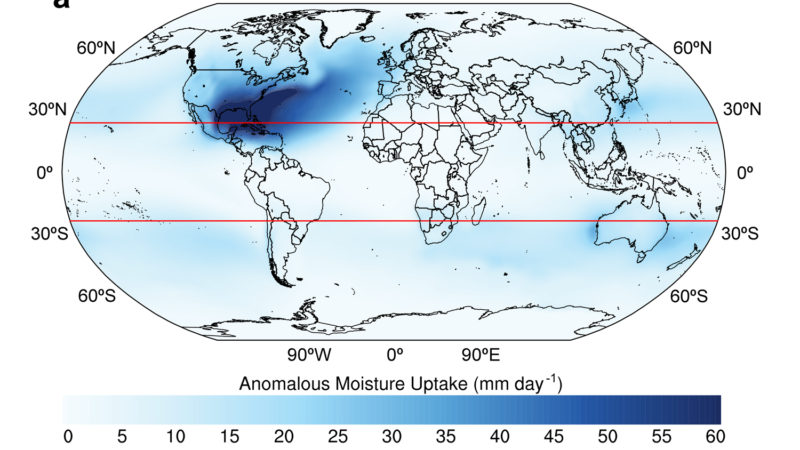The scientific journal Nature Communications published on Thursday an article led by researchers from the Ephyslab Group of the Marine Research Center of the University of Vigo (CIM-UVigo), in which it is indicated that the moisture of atmospheric rivers is increasing by 7% per every degree of increase in the global temperature of the planet. The text is the result of a study carried out on the 1980-2017 time period and its results “reveal a very important and significant increase in the amount of moisture from the regions that bring precipitable water that will be transported to the continents by the so-called atmospheric rivers”.
The article entitled Significant increase of global anomalous moisture uptake feeding landfalling atmospheric rivers is the result of a study carried out in the last year and a half directed by Luis Gimeno and Raquel Nieto and developed by Iago Algarra, all of whom belong to the Grupo Ephyslab from the CIM-UVigo. The article also includes researchers Jorge Eiras-Barca, also from Ephyslab, and Alexandre M. Ramos and Ricardo M. Trigo, from the Dom Luiz Institute of the University of Lisbon (Portugal), institute where Algarra carried out a research stay under protection of the FPI contract of which he is the beneficiary.
The “essential” role of atmospheric rivers
According to the Ephyslab researchers, “one of the strongest signs of climate change is the incessant increase in global mean surface temperature, which is closely related to the water vapor retention capacity of the atmosphere, which is also increasing ”. A more humid atmosphere, they detail, means a greater increase in moisture transport. In this context, atmospheric rivers, the authors of the work add in their analysis, “play an essential role since they are the main mechanisms of moisture transport from subtropical regions to extratropical regions”.
The results of the research presented in the Nature Communications article, indicate its authors, “reveal a positive trend in the moisture captured by atmospheric rivers in the same magnitude (7%) as the trend observed in water vapor at global level “. In addition, they add, the results show “that these increases in water vapor, which occur globally, also occur on a regional scale, with a greater supply of moisture from the northern hemisphere than from the southern hemisphere.” According to the authors of the work, the article detects the sources of anomalous absorption of humidity for these meteorological systems. The main contribution region is the Gulf of Mexico and the Caribbean Sea, which feed especially moisture to the atmospheric rivers that they develop in the Atlantic Ocean.
The detection of these sources of moisture associated with atmospheric rivers, they indicate, is carried out in the study by analyzing the changes in relative moisture in millions of volumes of air (particles) that are followed in their movement in the atmosphere by means of a model of Lagrangian dispersion. The authors have been working with this technique in the last decades. “Once the sources of moisture have been detected, and applying statistical techniques, it is observed that in the regions that are sources of moisture, during the period studied, which was 1980-2017, the approximate amount of moisture from the streams to atmospheric rivers is in openness increased”, the CIM-UVigo researchers explain. The importance of this increase, they point out, is that the same trend is being observed in the global atmosphere, with a 7% increase in water vapor for each degree of increase in surface atmospheric temperature. “Thus, and under the current context of global warming in which we find, the intensification of atmospheric rivers, due to this increase in the transport of moisture that feeds them, will have an even more relevant role in the hydrological cycle, increasing their socio-economic impact, since atmospheric rivers are responsible for many of the extreme precipitation events ”, the authors of the work emphasizes.
Contents of the first thesis of the Campus da Auga
The work presented in the article was part of the doctoral thesis presented by Iago Algarra and directed by Luis Gimeno and Raquel Olalla Nieto and focused on the study of the main atmospheric moisture transport mechanisms. The thesis, which obtained the highest qualification and was entitled Moisture transport associated with atmospheric rivers and low level tets at global scale, was the first defended in the Water, Sustainability and Development Doctoral Program, launched on the Ourense campus within the framework of its specialization project as Campus da Agua.
In addition, the article and the study that endorses it are part and give continuity to the line of work that the Ephyslab research group develops from the headquarters in the Campus da Agua building, on the Campus of Ourense. This line, the responsables explain, is focused “in recent years to determine the role of the atmosphere in moisture transport, analyzing in depth the role of this transport in the global and regional hydrological cycle.” Thus, they give as an example, at this time they have in force the project, funded by the then Ministry of Science, Innovation and Universities Lagrangian analysis of the impact on the global hydrological cycle of the major mechanisms of atmospheric moisture transport, in which frames the research now exposed in Nature Communications. They also have an active agreement with the European Space Agency for the validation of satellite water vapor products.
Source: DUVI

